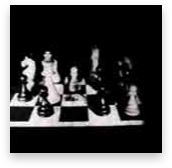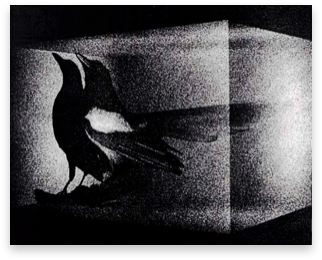Holography is an art form, not a gimmick
Michael Wenyon

That is not surprising. Optical scientists working on the technique in the 'sixties were often content to demonstrate the dramatic nature of the holographic process by using it to depict commonplace objects. Holograms of chessboards abounded –– to such an extent that the uninitiated observer could have been forgiven for thinking there was some important though unfathomable connection between holography and the ancient art of chess.
Although it is entirely appropriate to use holography to make replicas of objects (and much easier to pack a suitcase full of holographic copies of machine tools than to freight an actual demonstration product), it is hardly the most exciting way to use the technique. Of course the scientists claim that it is not their job to consider the aesthetics of the process. Their goal is to reproduce a fully three-dimensional natural colour image which is indistinguishable from the original object. And, if and when such hyper-realism becomes possible, it will certainly be useful. For example, holographic duplicates could be made of objects which are rare, valuable, difficult to transport or in imminent danger of decay (indeed, holograms are currently being made of many of the valuable artefacts stored in the Hermitage Museum in Leningrad: other museums can 'borrow' the exhibits, or the public can purchase them – in holographic form). But our skills of mechanical image making seem to have progressed so far towards realism that individual interpretation over and above the original choice of subject appears forgotten.
Perhaps the cold curse of realism, once placed at photography's doorstep, has finally found its resting-place in the house of holography. Yet we now dismiss claims that realism renders photography uninteresting. Photography produces images which are flat; it does not always reproduce colour as we see it; it presents us with only one point of view. Photographers exploit all these effects to lend an individual interpretation to a particular subject. So holography's critics should wait before they accuse it of being inescapably realistic.
For the moment the novelty of holograms ensures that almost any holographic display attracts interest and attention. Advertisers are bound to exploit this: even holographic poster hoardings are in the offing, once the technical and economic problems of 'scaling up' the holographic apparatus are solved. A pity, because this particular type of advertising displays will be the only way in which the vast majority of the public will become at all familiar with the holographic image. And a hologram of a can of baked beans has no more intrinsic interest than the original can.
Familiarity with the process will inevitably lead to boredom unless enterprising artists and graphic designers take a closer look at the holographic process and isolate those eye-catching visual tricks –– often applied with only subconscious awareness –– which have assured the effectiveness and longevity of other visual media.

Holography does not benefit from being portrayed as a piece of science fiction made fact. This only increases expectations and ultimately leads to disappointment. What holography does need is to be appraised in a calm and unemotional way –– and used where appropriate. Only then can it attain the respectability accorded to established technical media –– photography, film and television –– with which it has so much in common.
Michael Wenyon
Michael Wenyon is author of Understanding Holography
Caption: Margaret Benyon used double exposure technique to make 'Bird in a Box' (1973). Her use of holography is sensitive––'appropriate', even
